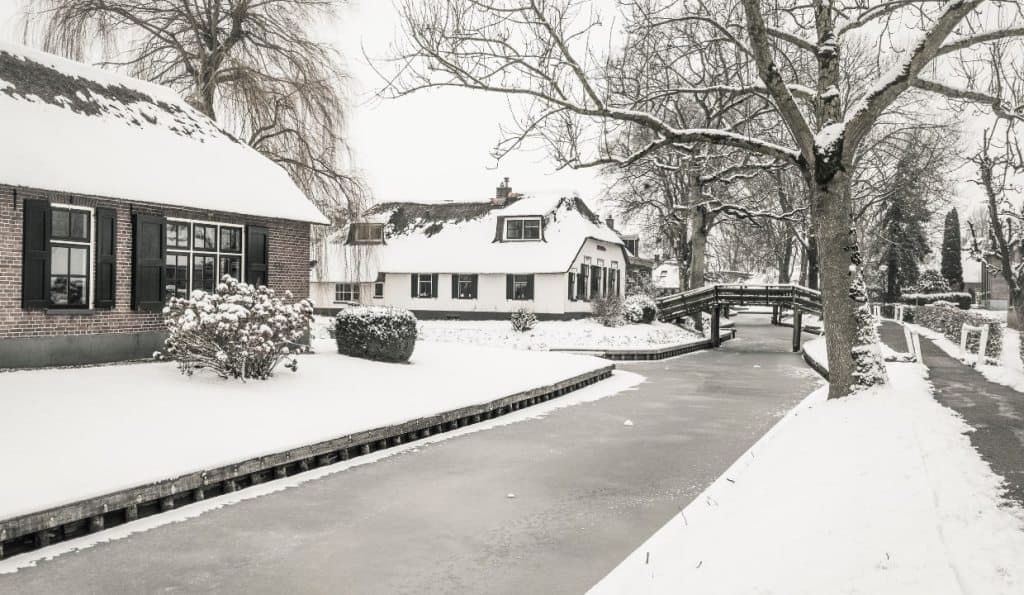Winter in the Netherlands is just perfect – cold and magical, neither freezing nor restraining. From December to February, the daily average temperatures are around 3°C (37 °F) and could drop to a freezing 0°C (32 °F) at night and around 6°C (43 °F) during the day. January is the coldest month, and visiting the country this time of year offers attractions and activities that you couldn’t enjoy it any other seasons of the year.
Winter in the east of Great Britain is very similar, but the Netherlands can be more extreme with colder cold days (and hotter hot days in summer). The good news is there is still plenty to enjoy in the Netherlands throughout the year, including the shivery winter nights. From December to February, tourists are still welcome to experience Giethoorn, an enchanting medieval town in the northeastern Dutch province of Overijssel.
Table of Contents
Giethoorn in Winter: Things to Do and See
Giethoorn, a farming village like no other
Widely known as the “Venice of the Netherlands”, Giethoorn is famous for its laid back, serene, and historic ambience that draws in thousands and thousands of local and international visitors every year. It is a road-less, car-less town with canals, thatch-roofed cottages, and farm-style homes, catapulting visitors to the Middle Ages when life was simple, quiet, and peaceful. Giethorn promises a trip to the past when life was simpler, more peaceful, and more genuine. Visitors are treated to clean air, quiet surroundings, and happy locals.
Giethoorn may be small but it is “big” in fame and attraction. Only two hours away from Amsterdam on a public commute, Giethoorn is a must-visit destination in the Netherlands, if only for the peace and quiet it brings. Like the rest of the country, Giethoorn is lovely all throughout the year. This farming village was founded around 1230. Its name means “Goat Horn” after the earliest settlers discovered goat horns buried in mud. The lovely fairy-tale-like atmosphere turns even more dreamy when snow begins to fall in winter. Below are some of the exciting things you can do in Giethoorn in the winter.
Skating on the frozen canals and lakes
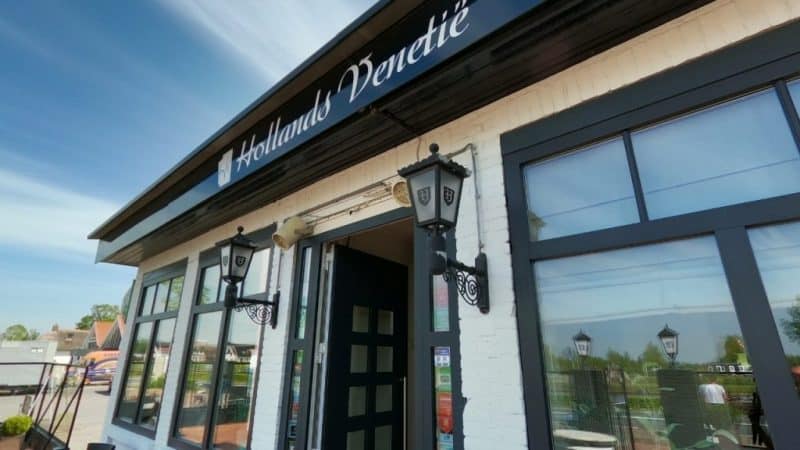
Giethoorn has intertwining canals that stretch for over 80 km, passing through 180 picturesque wooden arch bridges. For the rest of the year, canoes and boats make their way on these lovely canals, but in the winter, people put on their skates and take over. It doesn’t matter whether one is an expert skater or not. The picturesque scenery, the glimmering snowflakes, and the enchanting encounter are the biggest draw. It’s an experience that should not be missed when in the Netherlands.
The country is known for the Elfstedentocht, a 200-km long ice-skating event on natural ice. A speed skating competition and leisure tour, the Elfstedentocht, takes place in the northern province of Friesland and through 11 historical cities in the area. Elfstedentocht actually means “11 cities tour”, and according to the Washington Post, “The 110-year-old event is wildly popular — the next race is expected to attract 26,000 participants, 2 million spectators, and 3,000 journalists.” Sadly and unfortunately, this popular skating event doesn’t reach Giethoorn. Nonetheless, skating in this magical village is a once-in-a-lifetime experience.
In Giethoorn, a fun skating time in the canals usually ends with warm chocolate with whipped cream or a mulled wine in one of the many cafés and restaurants along the frozen waterways. Skaters should not miss visiting De Sloothaak restaurant, Hollands Venetië restaurant and the 2-Michelin-starred De Lindenhof. Enjoying a high tea in Giethoorn is just perfect, as well. Grab some scones, savoury sandwiches, chocolates, and muffins.
Sinterklaas in the frozen village
When in the Netherlands in December, experience the Dutch brand of Christmas on the 5th of the month. We call it Sinterklaas, and it is a special day for little kids. Sinterklaas (or Saint Nicholas) is the Dutch Father Christmas or Santa Claus. Sinterklaas is highly anticipated in Giethoorn and elsewhere in the country, but the largest Saint Nicholas parade always takes place in Amsterdam. The capital city, not far from Giethoorn, is the center of fun and festivities, including this long-held Christmas tradition.
Sinterklaas arrives with floats and boats lined for more than a kilometre, handing out small spiced biscuits to thousands of spectators along the canals. The number of viewers could reach 400,000. Following tradition, Sinterklaas enters the capital city on Amstel River and sails through Nieuwe Amstelbrug, Toronto Rug, the Hoge Sluis by the Royal Theatre Carré, and the Magere Brug, ultimately ending at the Scheepvaartmuseum (Maritime Museum).
Sinterklaas in the small village of Giethoorn may not be as grand, but the local children never fail to lay out their shoes before bedtime, hoping to get a gift from old Sint the next morning. Children who have been nice expect to get chocolate letters and marzipan, while those who’ve been naughty could get a piece of coal.
Visit a museum when there’s not much to do outside
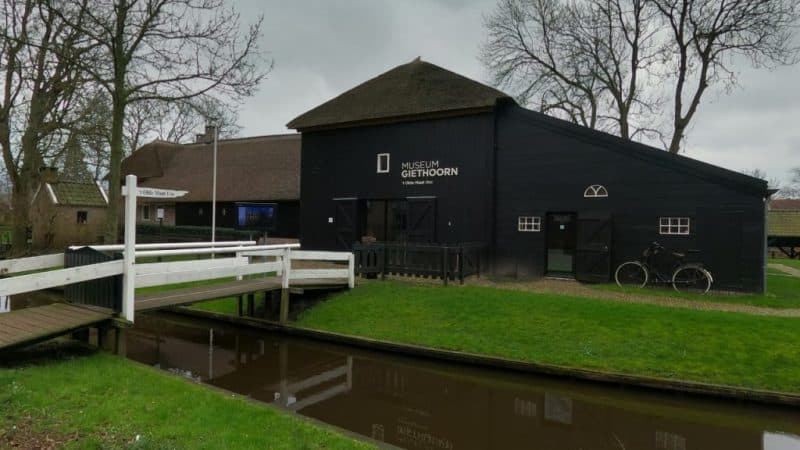
Winter, spring, summer, or fall, a trip to Giethoorn is not complete without visiting the museums, although the best time to see them is in the winter when there isn’t a lot to do outside. To some, the winter is a time of inactivity. In Giethoorn, however, the museums offer an exciting, intriguing, and information-filled option for everyone.
One of the most popular museums is the Olde Maat Uus Museum. Located within an original and typical farmhouse from the bygone years, Olde Maat Uus is a living museum that showcases a historic farming village with actors in costume. They go about with the daily chores, mimicking how the Dutch in this part of the country used to spend their days. People will see first-hand how the residents of Giethoorn used to live more than 100 years ago and how they worked hard cutting peat and building punters or small boats. Each visit typically takes 1-2 hours.
A recent tourist described the farmhouse museum this way: “It is a nice small museum which gives you all the information about the past. It is amazing to know that the landscape as it is today was man-made. All the canals (in Giethoorn) were dug out by workers who cut turf which was used as fuel for the fire, for heating, and cooking. The museum tells you all about how it came about, how the people used to live, and what life was like hundreds of years ago. Very educational and interesting.”
Other visitors said, “We visited the museum and we loved it. You can find a lot about Giethoorn by just visiting this place. You go back in history to see how the people of Giethoorn lived. It is definitely worth visiting.”
Meanwhile, gem and treasure lovers should visit another popular museum in the village – the De Oude Aarde museum. It is known for its precious gemstones, pieces of jewellery, fossil minerals, and natural treasures from all over the world, including the world’s largest egg. An added attraction is the owner himself. He makes sure to always mingle with guests, talking about the artefacts with a great deal of passion. Even the gift shop outside the museum features a large selection of rocks, stone artwork, and decorations. One doesn’t even need to go inside to appreciate the place and the artefacts.
One satisfied visitor to De Oude Aarde said, “If you love rocks, fossils and crystals this is definitely the place for you. Not only do you get to see petrified wood, but also gigantic amethysts, azurites, sapphires, and so on.”
All the museums, churches, boutiques, and restaurants in the village are reachable by foot (and boats during the other seasons of the year).
Cycling in Giethoorn
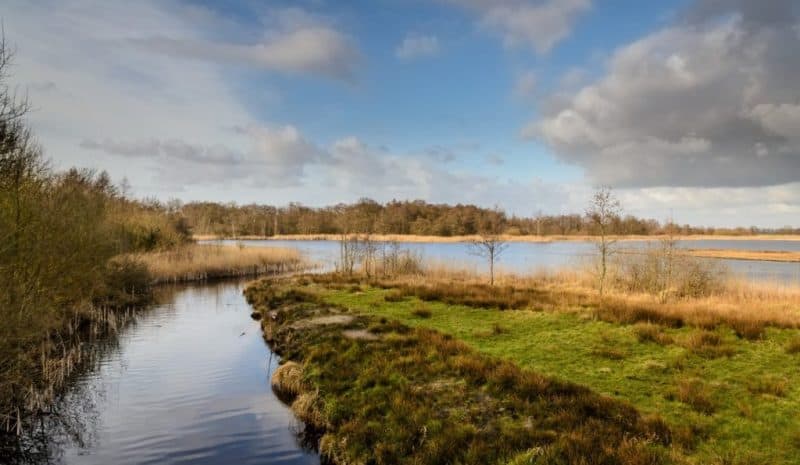
You can’t go anywhere in the Netherlands without enjoying a scenic and lovely bicycle ride. Before the village freezes entirely, take time to cycle in Giethoorn in the winter along several cycling routes to choose from. If the weather allows, go cycling to the nearby Weerribben-Wieden National Park and enjoy the meadows and forests. This is the most popular park in the area and a definite must-see destination.
For the Dutch, two-wheeling is a way of life, and so while here, don’t miss renting a bike to explore the unique charm of this dreamy village. Enjoy cycling on the wooden bridges and watch the skaters whizz by below you on the frozen canals. Cycling and simply strolling around Giethoorn in summer is lovely, but it becomes truly magical with the falling snow in the winter. Seeing the green lawns and thatched roofs covered in a white blanket of ice will definitely stay with you for a long time, including the trees with glistening snowflakes.
Activities in Giethoorn all year round
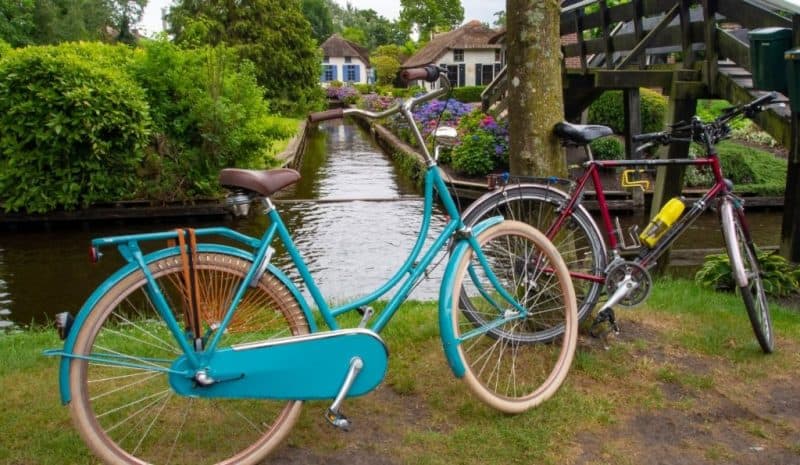
Giethoorn is quite an attraction in all months of the year. People come in the summer for the festivals, boat rides, and summer market; in the spring for the tulips and other blooms; while in the winter, for the snow and frozen waterways. Several activities and promotions are organised in the village throughout the year, and the 3,000 residents are most welcoming.
Giethoorn is perhaps one of the quietest destinations in Europe, but it becomes less quiet during the months of April to October, which is the peak season for tourism. It becomes a bit crowded (but still relatively peaceful compared with other leading destinations) on Sundays, during national holidays, and school holidays.
June, July and August are when the village is most colourful with all the gorgeous flowers in full bloom. In the winter, only those who love snow and skating are wise enough to come and lucky enough to see the village covered in white splendour.
When in the Netherlands in the winter, Giethoorn awaits. To get there, you can easily get a train ride or rent a private vehicle from Amsterdam. If the winter is too cold and gloomy for you to drive, then take the train from Amsterdam Zuid/Centraal Station to Steenwijk. From there, get on Bus 70 to reach Dominee Hylkemaweg stop and then walk for a short distance to the village.
Author Bio: Ask The Dutch Guy is your go-to guide when it comes to The Netherlands. The goal of Ask The Dutch Guy is to showcase the beauty of The Netherlands and to inspire others to explore the country. Read more about Ask The Dutch Guy at https://askthedutchguy.com. Follow him on Facebook and Instagram.

